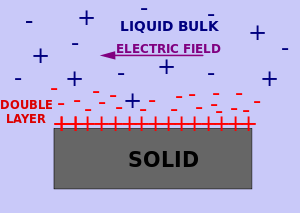Surface conductivity
Surface conductivity is an additional conductivity of an electrolyte in the vicinity of charged surfaces.[1] Close to charged surfaces a layer of counter ions of opposite polarity exists which is attracted by the surface charges. This layer of higher ionic concentration is a part of the interfacial double layer. The concentration of the ions in this layer is higher as compared to the volume conductivity far from the charged surface and leads to a higher conductivity of this layer.

Smoluchowski was the first to recognize the importance of surface conductivity at the beginning of the 20th century.[2]
There is a detailed description of surface conductivity by Lyklema in "Fundamentals of Interface and Colloid Science" [3]
The Double Layer (DL) has two regions, according to the well established Gouy-Chapman-Stern model, Ref.2. The upper level, which is in contact with the bulk fluid is the diffuse layer. The inner layer that is in contact with interface is the Stern layer.
It is possible that the lateral motion of ions in both parts of the DL contributes to the surface conductivity.
The contribution of the Stern layer is less well described. It is often called "additional surface conductivity".[4]
The theory of the surface conductivity of the diffuse part of the DL was developed by Bikerman.[5] He derived a simple equation that links surface conductivity κσ with the behaviour of ions at the interface. For symmetrical electrolyte and assuming identical ions diffusion coefficients D+=D−=D it is given in Ref.2:
where
- F is the Faraday constant
- T is the absolute temperature
- R is the gas constant
- C is the ionic concentration in the bulk fluid
- z is the ion valency
- ζ is the electrokinetic potential
The parameter m characterizes the contribution of electro-osmosis to the motion of ions within the DL:
The Dukhin number is a dimensionless parameter that characterizes the contribution of the surface conductivity to a variety of electrokinetic phenomena, such as, electrophoresis and electroacoustic phenomena.
See also
References
- ↑ Surface and volume conductivity correspond to the electrically driven motion of ions in an electric field.
- ↑ M. von Smoluchowski, Physik, Z., 6, 529 (1905)
- ↑ Lyklema, J. "Fundamentals of Interface and Colloid Science", vol. 2, Academic Press, 1995
- ↑ Dukhin, S.S. and Derjaguin, B.V. "Electrokinetic Phenomena", John Wiley and Sons, New York (1974)
- ↑ Bikerman, J.J. Z.Physik.Chem. A163, 378, 1933

